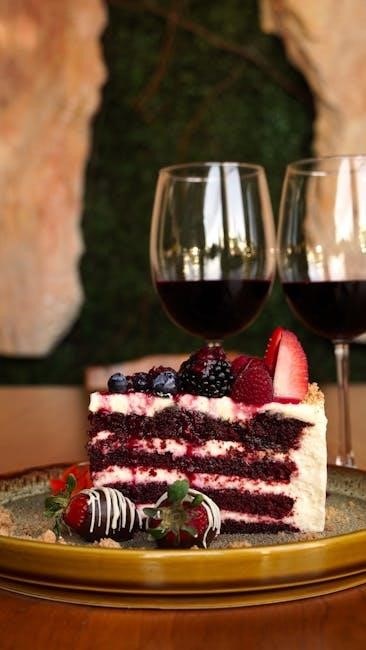Discover the art of harmonizing flavors with a downloadable Wine and Food Pairing Chart PDF. Perfect for red meat, fish, or vegetables, it simplifies pairing, ensuring acidity and salt levels enhance your dining experience.
Understanding the Basics of Wine and Food Pairing
Wine and food pairing is an art that balances flavors, textures, and aromas to elevate dining experiences. It involves matching wines with dishes based on acidity, sweetness, tannins, and body. Foods high in acid or salt are often easier to pair, as they complement wines with similar traits. For example, acidic foods like citrus or tomatoes pair well with crisp, high-acid whites. Red wines with firm tannins are ideal for fatty meats or rich flavors. The goal is to create harmony, where neither the wine nor the food overpowers the other. A Wine and Food Pairing Chart PDF serves as a practical guide, offering tailored recommendations for red meat, fish, vegetables, and more. By understanding these principles, you can confidently select wines that enhance your meals, ensuring a delightful and balanced dining experience every time.
Why a Wine and Food Pairing Chart is Essential
A Wine and Food Pairing Chart is an indispensable tool for anyone seeking to elevate their dining experience. It provides a clear guide for selecting wines that complement a variety of dishes, from red meat and fish to vegetables and plant-based options. By offering tailored recommendations, the chart simplifies the often complex process of pairing, ensuring that each meal is balanced and flavorful. It highlights how acidity, sweetness, and tannins in wines can enhance or contrast with the flavors of food. Whether you’re planning a special occasion or a casual meal, the chart serves as a quick reference to make informed decisions. Additionally, it caters to diverse tastes by covering a wide range of wines, including light whites, aromatic whites, full-bodied reds, and refreshing rosés. With a Wine and Food Pairing Chart, you can effortlessly create harmonious pairings that delight your palate and impress your guests.
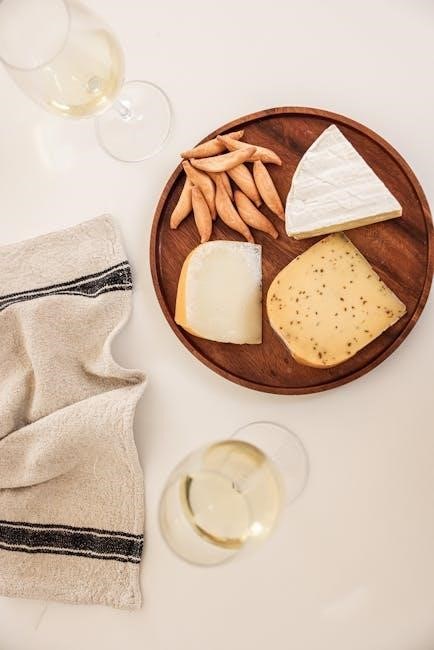
Types of Wine for Pairing
Explore white, red, sparkling, and dessert wines, each offering unique profiles for pairing. From crisp whites like Sauvignon Blanc to bold reds like Cabernet, these wines cater to diverse dishes and tastes.
White Wines: Chardonnay, Sauvignon Blanc, Pinot Grigio, and More
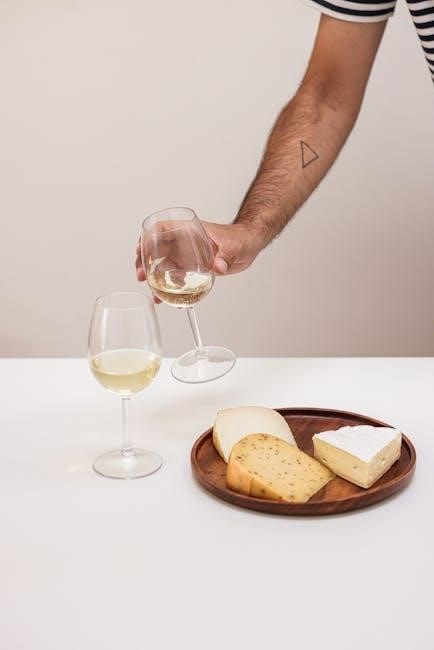
White wines offer a diverse range of flavors, from buttery Chardonnay to crisp Sauvignon Blanc. Chardonnay, aged in oak, pairs beautifully with rich dishes like roasted chicken or creamy sauces. Sauvignon Blanc, with its citrus and grassy notes, complements seafood and salads. Pinot Grigio, light and refreshing, is ideal for delicate flavors like fish or vegetarian dishes. Riesling, ranging from sweet to dry, pairs well with spicy or acidic foods. Gewürztraminer, aromatic and slightly sweet, matches Asian cuisine and strong cheeses. Chenin Blanc and Moscato add variety with their fruity and floral profiles. These white wines provide versatility for any meal, ensuring a perfect match for diverse culinary creations.
Red Wines: Cabernet Sauvignon, Merlot, Pinot Noir, and More
Red wines are known for their bold flavors and pairing versatility. Cabernet Sauvignon, with its robust tannins, pairs perfectly with red meats like beef and lamb. Merlot, smoother and approachable, complements pasta dishes and lean meats. Pinot Noir, light-bodied with earthy notes, is ideal for delicate flavors like salmon or poultry. Syrah/Shiraz offers spicy and dark fruit flavors, matching well with robust dishes such as game meats or hearty stews. Malbec, with its plum and blackberry notes, is great for grilled meats, while Grenache-based blends add warmth and spice to pair with cured meats or spicy dishes. These red wines provide a rich spectrum of options for enhancing your dining experience, ensuring there’s a perfect match for every meal.
Sparkling and Dessert Wines for Special Pairings

Sparkling wines like Champagne and Prosecco add elegance to any occasion, pairing beautifully with appetizers, seafood, and celebratory dishes. Their crisp acidity cuts through richness, making them ideal for caviar or creamy sauces. For sweet endings, dessert wines such as Sauternes, Moscato, and Port are perfect. Sauternes, with its honeyed sweetness, complements foie gras or ripe cheeses, while Moscato’s fruity notes enhance fresh desserts like sorbet. Port wine, rich and robust, pairs wonderfully with chocolate truffles or nutty dishes. These wines are tailor-made for special moments, offering a delightful contrast to savory meals. Incorporating them into your Wine and Food Pairing Chart PDF ensures every course, from start to finish, is memorable and harmonious.
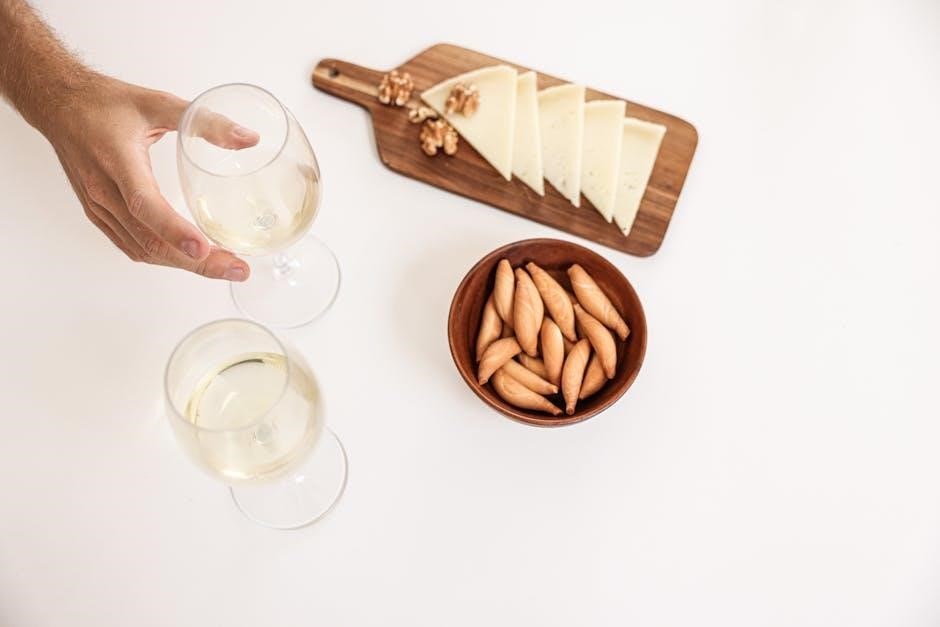
Popular Food Categories for Pairing

Explore red meat, fish, and vegetables with our Wine and Food Pairing Chart PDF. Acidic or salty dishes pair best with wines of similar acidity, ensuring balanced and delightful flavor combinations.
Red Meat: Beef, Lamb, and Game
Red meat dishes, such as beef, lamb, and game, are perfectly complemented by robust wines that can stand up to their rich, bold flavors. A wine and food pairing chart PDF often recommends full-bodied red wines like Cabernet Sauvignon, Syrah/Shiraz, or Malbec for these hearty meals. These wines are known for their tannins, which help balance the fattiness of red meat. For example, a grilled ribeye pairs exceptionally well with a Cabernet Sauvignon, while a braised lamb shank might be better suited to a Syrah. Game meats like venison or wild boar also benefit from the complexity of these wines, as their earthy and spicy notes enhance the overall dining experience. The chart provides clear guidelines to ensure every red meat dish is paired with a wine that elevates its flavors, making meal planning effortless and enjoyable. Whether you’re grilling, roasting, or braising, the right wine pairing is just a glance away;
Fish and Seafood: Delicate to Rich Options
Fish and seafood offer a wide range of flavors, from delicate to rich, making them versatile for wine pairing. A wine and food pairing chart PDF suggests light, crisp white wines like Sauvignon Blanc or Pinot Grigio for delicate fish such as sole or flounder. These wines complement the subtle flavors without overpowering them. For richer fish like salmon or tuna, a buttery Chardonnay or a dry Rosé pairs beautifully, enhancing their bold and oily textures. Seafood like shrimp or scallops can be paired with sparkling wines or light whites, while lobster and mussels might call for a rich, oaky Chardonnay. The chart also considers cooking methods and seasonings, such as citrus-herb marinades or garlic butter sauces, to guide perfect pairings. Whether you’re serving a delicate sole or a hearty seafood paella, the PDF chart ensures every dish is matched with a wine that enhances its unique flavor profile.
Vegetables and Plant-Based Dishes
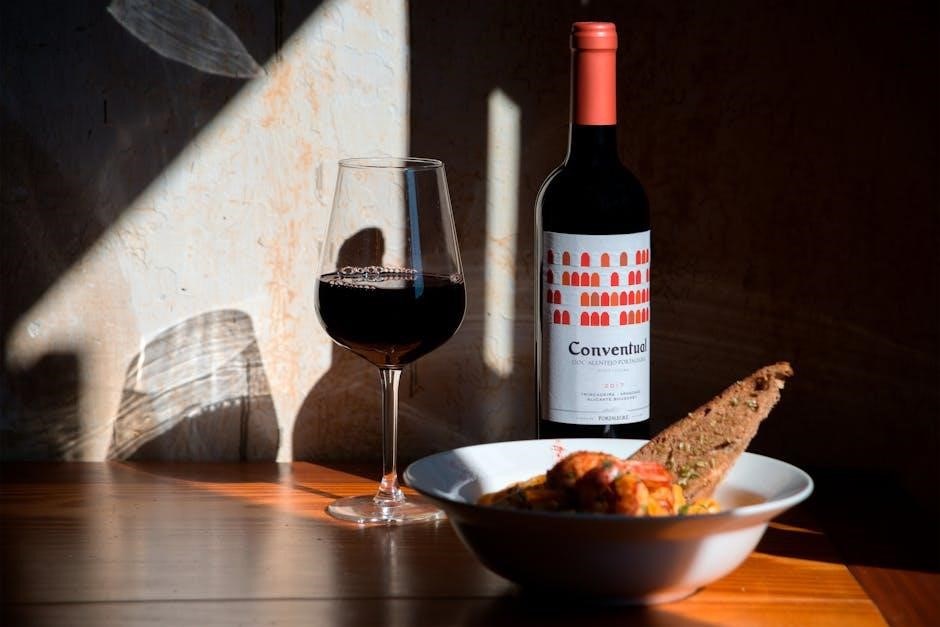
Vegetables and plant-based dishes offer a vibrant canvas for wine pairing, with flavors ranging from earthy to bright and herbaceous. A wine and food pairing chart PDF highlights how crisp whites like Sauvignon Blanc or Pinot Grigio complement fresh, green vegetables such as asparagus or spinach, while earthier options like mushrooms or eggplant pair beautifully with light reds like Pinot Noir or Beaujolais. For roasted vegetables, a dry Rosé or Grenache Blanc adds a refreshing contrast, balancing rich, smoky flavors. Plant-based dishes, such as lentil stews or vegetable curries, can be paired with aromatic whites like Gewürztraminer or Riesling, which enhance their spicy and herbal notes. The chart also considers texture and seasoning, suggesting wines that cut through creamy sauces or amplify umami flavors in dishes like stuffed bell peppers or grilled portobello mushrooms. With the PDF as your guide, every plant-based meal can be elevated by a thoughtfully chosen wine.
Creating Your Own Wine and Food Pairing Chart
Design a personalized chart by categorizing wines and dishes, focusing on flavor profiles, acidity, sweetness, and tannins. Consider personal preferences and dietary needs, ensuring a balanced and harmonious pairing experience.
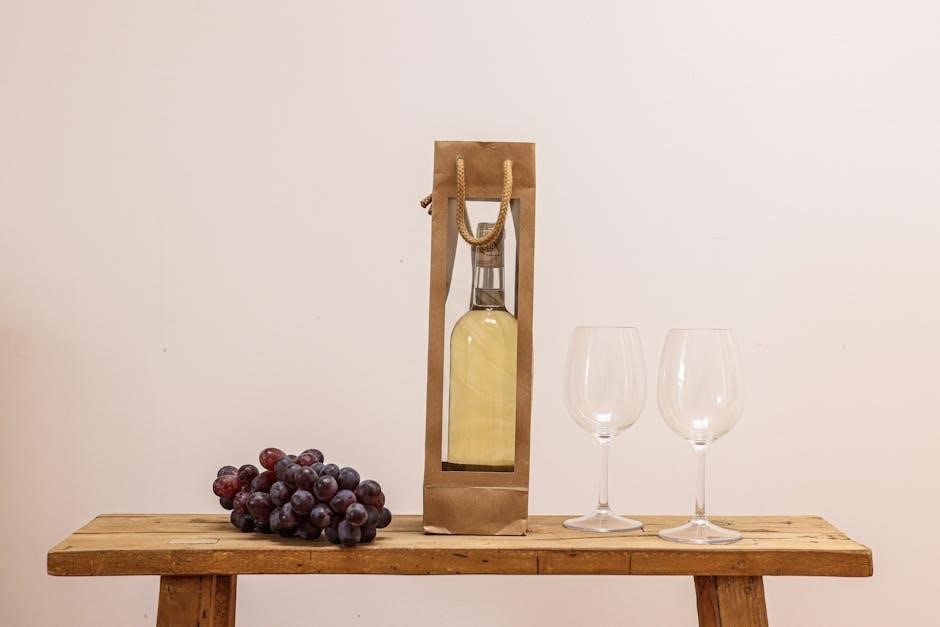
Key Flavor Profiles to Consider
When developing a wine and food pairing chart, understanding key flavor profiles is crucial. Wines can be categorized by their acidity, sweetness, tannins, and fruitiness, while foods are defined by their richness, spice, and texture. For instance, a crisp Sauvignon Blanc pairs well with citrus-herb dishes, while a bold Cabernet Sauvignon complements hearty meats. Earthy Pinot Noir aligns with mushroom-based dishes, and sweet Riesling balances spicy cuisine. Vegetables and plant-based meals often benefit from light, herbal whites like Pinot Grigio. Consider how flavors in food, such as umami in soy sauce or bitterness in greens, interact with wine elements. This analysis helps create harmonious pairings, enhancing both the wine and the dish. By focusing on these core flavor profiles, you can build a chart that guides intuitive and enjoyable combinations for various dining experiences.
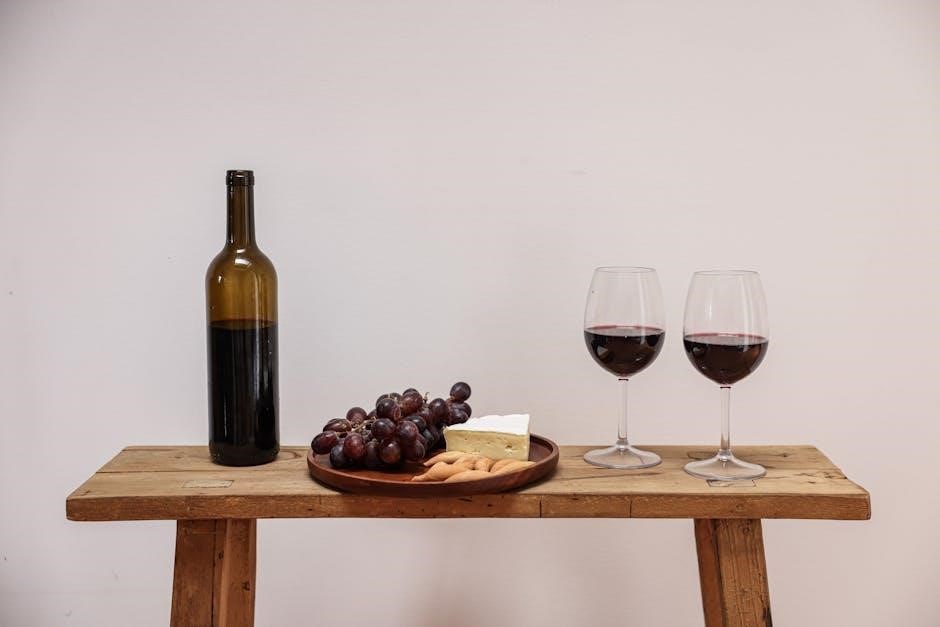
Matching Wine and Food by Acidity, Sweetness, and Tannins
Acidity, sweetness, and tannins are fundamental elements in wine and food pairing. Wines with high acidity, such as Sauvignon Blanc, cut through richness and complement fatty or creamy dishes. Sweet wines, like Riesling, balance savory or spicy flavors, creating harmony. Tannins, found in red wines like Cabernet Sauvignon, add structure and pair well with fatty meats or umami-rich foods. When matching, consider how these elements interact: crisp acidity enhances bright flavors in seafood, while tannins soften the boldness of red meat. Sweetness in wine can mirror or contrast the sweetness in food, offering balance. For example, a dry wine pairs with savory dishes, while a sweet wine complements desserts. By focusing on acidity, sweetness, and tannins, you can craft pairings that elevate both the wine and the meal, ensuring a balanced and enjoyable dining experience.
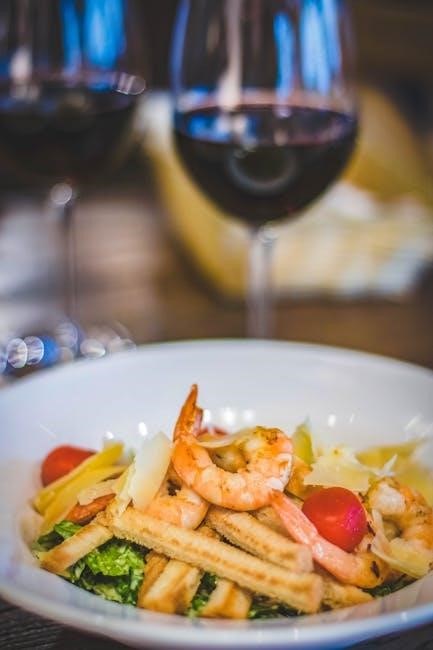
Herbs, Seasonings, and Wine Pairing
Herbs and seasonings enhance flavor profiles, guiding wine choices. Basil pairs with crisp whites, while rosemary complements bold reds. A wine and food pairing chart helps match seasonings to ideal wines, optimizing taste harmonies.
Common Herbs: Basil, Thyme, Parsley, and More
Common herbs like basil, thyme, and parsley play a significant role in shaping the flavor profiles of dishes, influencing wine pairing decisions. Basil, with its bright, citrusy notes, pairs beautifully with crisp white wines like Sauvignon Blanc or Pinot Grigio. Thyme, earthy and savory, complements red wines such as Cabernet Sauvignon or Syrah, enhancing their robust flavors. Parsley, fresh and green, works well with lighter, herbaceous whites like Grüner Veltliner. A wine and food pairing chart can help identify these harmonies, guiding you to select wines that elevate the herbal nuances in your meals. By understanding how these herbs interact with wine, you can create balanced and enjoyable dining experiences. This section provides practical insights to enhance your pairing skills, ensuring every dish, from subtle to bold, is matched with the perfect wine.
Exotic Spices and Seasonings: Saffron, Nutmeg, and Ginger
Exotic spices like saffron, nutmeg, and ginger add unique dimensions to dishes, requiring thoughtful wine pairings to enhance their complex flavors. Saffron, with its earthy, floral notes, pairs beautifully with rich, oaky whites like Chardonnay or aromatic wines such as Gewürztraminer. Nutmeg, warm and slightly sweet, complements fortified wines like Port or sweet dessert wines, balancing its aromatic warmth. Ginger, spicy and zesty, works well with crisp, acidic whites such as Riesling or sparkling wines like Prosecco, cutting through its boldness. A wine and food pairing chart can simplify these selections, offering tailored recommendations for dishes featuring these spices. By aligning the wine’s acidity, sweetness, and tannins with the spice’s intensity, you can create harmonious and memorable meals. This guide helps you navigate the world of exotic spices and their ideal wine matches, ensuring every flavor shines.
Downloadable Wine and Food Pairing Chart PDF
A practical guide to perfect pairings, this downloadable chart offers a quick reference for matching wines with dishes, ensuring a seamless and enjoyable dining experience for every occasion.
How to Use the Chart for Perfect Pairings
To use the wine and food pairing chart effectively, start by identifying the type of dish you’re preparing. Match its primary ingredients to the recommended wine styles. Consider the flavor profile, acidity, sweetness, and tannins in both the food and wine. For example, pair a rich, fatty dish like roasted beef with a bold red wine high in tannins, such as Cabernet Sauvignon. For delicate fish, opt for a crisp white wine like Sauvignon Blanc. Adjust based on personal taste, as preferences for sweetness or acidity can vary. Experiment with combinations to find your ideal matches; The chart serves as a guide, but feel free to explore and refine your pairings over time. This tool is especially helpful for special occasions, dinner parties, or when trying new cuisines. By following these steps, you can elevate your dining experience and impress your guests with harmonious pairings.
Enhancing Your Dining Experience with the Chart
Using a wine and food pairing chart can elevate your dining experience by adding sophistication and thoughtfulness to every meal. It helps you discover new flavor combinations and ensures that your wine complements the dish, enhancing the overall taste. Whether you’re hosting a dinner party or enjoying a quiet evening, the chart serves as a quick reference to make informed pairing decisions. It also introduces you to lesser-known wines and cuisines, broadening your culinary horizons. By consistently using the chart, you’ll develop a deeper understanding of how flavors interact, allowing you to refine your palate and explore new pairing possibilities. This tool not only simplifies the process but also makes every dining occasion more enjoyable and memorable.
